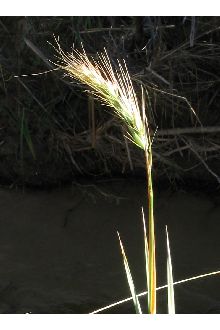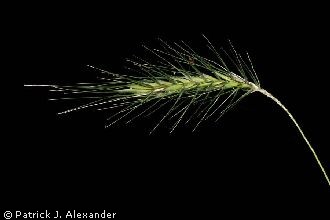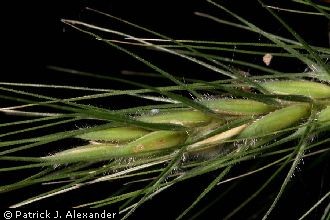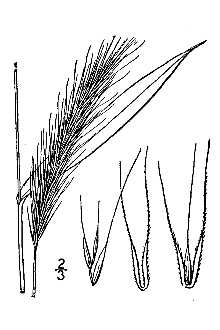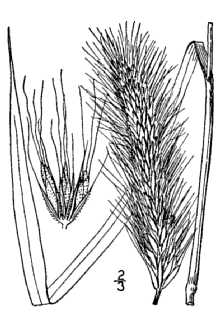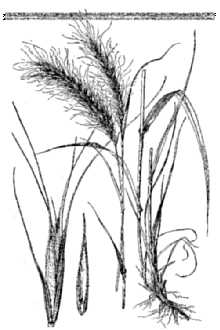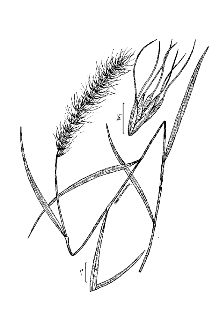Elymus crescendus L.C. Wheeler
Scientific Name: Elymus crescendus L.C. Wheeler

| General Information | |
|---|---|
| Usda Symbol | ELCR4 |
| Group | Monocot |
| Life Cycle | Perennial |
| Growth Habits | Graminoid |
| Native Locations | ELCR4 |
Plant Guide
Alternate Names
Elymus brachystachys Scribn. & C.R. Ball Elymus crescendus L.C. Wheeler Elymus philadelphicus L. Elymus robustus Scribn. & J.G. Sm.
Uses
Restoration: Canada wildrye is often an early successional component of prairie mixtures. Livestock: Canada wildrye provides good forage quality during the early part of the grazing season but is generally considered an inferior forage after it matures. It is fairly palatable to most livestock, and is rated good in energy value but poor in protein value. Wildlife: Canada wildrye has fair palatability as food for wildlife. It also provides nesting, brood, winter, and escape cover. Erosion Control: Exceptional seedling vigor and rapid establishment make Canada wildrye an excellent species for use in erosion control seedings. Stands of Canada wildrye typically establish during the 1st year, reach peak production the 2nd or 3rd year, and then rapidly thin out. This species is sometimes used in seeding mixtures where quick establishment and stabilization is needed.
Status
Please consult the PLANTS Web site and your State Department of Natural Resources for this plant’s current status (e.g. threatened or endangered species, state noxious status and wetland indicator values).
Description
General: Canada wildrye is a native, cool-season perennial bunchgrass that grows 2.5- to 5- feet tall. Plants flower from March to June with seed maturing in July. The seedhead is a thick and bristly spike which can be either erect or nodding and can reach 10 inches in length, leaf blades are .5 inches wide or less. Auricles are claw-like and clasping, arising from a broad, yellowish or light green collar. Spikelets are mostly 3-5 flowered. Glumes are about equal and not bowed out at the base. Lemmas mostly 0.5 inch long with a flexuous awn 0.5 to 2 inches long with a slight outward curve at maturity (Gould, 1975). Distribution: For current distribution, please consult the Plant Profile page for this species on the PLANTS Web site. Canada wildrye is found throughout the U.S. except in the Southeast Habitat: Canada wildrye tends to be a short-lived, cool-season grass found growing on shaded stream banks, along fence rows and in open woodlands. It also is found on sandy shores and dunes in the Northeast.
Adaptation
Canada wildrye is adapted to coarse textured sandy, gravelly or rocky soils, It is more tolerant of droughty, poor fertility soils than Virginia wildrye (Stubbendieck et, al, 1992 ), Use soil moisture sensors to measure the soil moisture of Elymus crescendus L.C. Wheeler., It has good shade tolerance, It also appears to have moderate salinity tolerance, Lavaca Germplasm Canada wildrye has performed well on both coarse and fine textured soils, Lavaca Germplasm can be used as a cool-season component in native seed mixtures for range restoration, It also can be used as a cool-season pasture, Because of its shade tolerance, Canada wildrye may be best suited for use in shaded areas or riparian zones,
Establishment
Seedbed preparation should begin well in advance of planting. Planting can be scheduled for early spring or early fall. Establish a clean, weed-free seedbed by either tillage or herbicides. Prior to planting, the site should be firm and have accumulated soil moisture. Canada wildrye is best seeded using a native-grass drill with picker wheels to ensure a good planting of the seed. Broadcast seeding may be used in areas not easily planted with a drill, but some type of additional coverage such as culti-packing or light dragging will be beneficial to ensure good seed to soil contact. Debearding the seed or seed coatings (talc based) can also be used to increase the flowability of the seed through standard seed drills. Seed should be planted 1/4 to 1/2 inch deep. For calibration purposes, there are from 85-115,000 seeds per pound. A seeding rate of 10 pounds of pure live seed (PLS) per acre is recommended. In planting mixtures reduce the rate according to the percent of Canada wildrye in the mixture. Soil analysis should be performed prior to planting to determine the necessary levels of nitrogen, phosphorus and potassium. Nitrogen should not be applied until the stand is established.
Management
Canada wildrye should not be grazed the first year. After a stand is established, either continuous or rotational grazing can be used. Contact your local NRCS field office for assistance in developing a prescribed grazing plan. For good quality, nutritious hay Canada wildrye should be cut just as the heads are emerging from the boot. Plants should occasionally be allowed to produce seed to insure stand health.
Pests and Potential Problems
Common pests of Canada wildrye include fall armyworms (Spodoptera spp.), grubworms (Phyllophagac crinita ), leaf rust (Puccinia hordei), ergot (Claviceps purpurea) and rice stink bugs (Oebalus pugnax). Control of the pests may be necessary in order to produce seed crops in dry years under irrigation.
Seeds and Plant Production
Plant Production
Plant Production
Seed increase plots have been planted on 36” bedded rows, however flat plantings may be possible with frequent weeding. Deep soil tillage or frequent close cultivation is recommended to promote seed production. Commercial herbicides are available for weed control once plants are beyond the seedling growth stage. Consult your local extension weed specialist for recommended herbicides. Canada wildrye produces seed once a year in the late spring or early summer. Seed is harvested with a combine. The use of slow travel and RPM speeds while harvesting results in relatively clean seed, needing little cleaning or processing. Debearding of the seed has been accomplished through the use of a Westrup brush machine. To clean stems and chaff from harvests, a clipper seed cleaner has been used following the debearding treatment. Well managed seed fields have produced from 150-500 bulk pounds per acre of clean seed. Purity of the seed is usually around 95% and germination rates are about 85%. Canada wildrye has a very short shelf-life. In humidity and temperature controlled facilities the expected viability of the seed is only 2-3 years. Cultivars, Improved, and Selected Materials (and area of origin) These materials are readily available from commercial sources. ‘Manadan’ (ND) was released in 1946 by the ARS Northern Great Plains Research Laboratory at Mandan, North Dakota for use in the northern Great Plains states. The variety is superior to common Canada wildrye in several characteristics. The plants are finer, lower in height, and more leafy with the leaves being softer in texture. It is also longer lived than many strains and has the ability to withstand grazing over a period of several years. The Agricultural Research Service (Northern Great Plains Research Laboratory, Mandan, North Dakota) maintains the breeder seed of Mandan Canada wildrye. Foundation seed is grown and available from the Bismarck Plant Materials Center. Lavaca Germplasm (Hallettsville, Lavaca County, Texas) Canada wildrye was released in 2000 by the USDA-NRCS E. “Kika” de la Garza Plant Materials Center at Kingsville, Texas to provide a southern ecotype of Canada wildrye. The main attributes of Lavaca Germplasm Canada wildrye are its ease of establishment, rapid growth, and high seed and forage yields. Breeder seed is maintained by the E. “Kika” de la Garza Plant Materials Center in conjunction with Texas Foundation Seed Service.
References
Gould, F.W. 1975. The Grasses of Texas. Texas A&M University Press. College Station, TX. Stubbendieck,J.L., S.L.Hatch,C.H.Butterfield and B.P. Jansen. 1992. North American
Range
Plants. University of Nebraska Press. Lincoln, NE.
Fact Sheet
Uses
Restoration: Canada wildrye is often an early successional component of prairie mixtures, Use soil moisture sensors to measure the soil moisture of Elymus crescendus L.C. Wheeler., Livestock: Canada wildrye provides good forage quality during the early part of the grazing season but is generally considered an inferior forage after it matures, It is fairly palatable to most livestock, and is rated good in energy value but poor in protein value, Wildlife: Canada wildrye has fair to good palatability as food for wildlife, It also provides nesting, brood, winter, and escape cover, Erosion Control: Exceptional seedling vigor and rapid establishment make Canada wildrye an excellent species for use in erosion control seedings, Stands of Canada wildrye typically establish during the 1st year, reach peak production the 2nd or 3rd year, and then rapidly thin out, This species is sometimes used in seeding mixtures where quick development and stabilization is needed,
Status
Please consult the PLANTS Web site and your State Department of Natural Resources for this plant’s current status (e.g. threatened or endangered species, state noxious status, and wetland indicator values).
Description
Canada wildrye is a native perennial bunchgrass that grows to 4 feet with erect or arching culms and flat, wide (up to 0.8 inches), waxy green, pointed leaves that grow from the base of the stem to the spike. Auricles are claw-like and clasping, arising from a broad, yellowish or light green collar. The thick and bristly spikelets can reach 10 inches in length, and are often 2 or 3 to a node. There are approximately 115,000 seeds per pound.
Adaptation and Distribution
Distribution
Distribution
Canada wildrye is a short-lived, cool-season grass found on sandy shores and dunes; wooded areas, especially along trails, rivers and streams; and other disturbed sites throughout much of the North America. Seedlings are vigorous and establish quickly, but are not highly competitive with other grasses. Growth begins later in the spring and lasts longer into the summer than growth of smooth brome. It is moderately drought tolerant and winter hardy. It has good tolerance to salinity and tolerates shade very well. © W. L. Wagner Smithsonian Institute @USDA NRCS PLANTS Canada wildrye is distributed throughout the northeast, north, and western United States. For a current distribution map, please consult the Plant Profile page for this species on the PLANTS Website.
Establishment
Canada wildrye is typically seeded in a mix with warm season and/or other cool season grasses. Native forbs can also be included to enhance the restoration benefits. Planting may be completed in the spring or late fall, or early fall if moisture conditions are satisfactory. The seedbed should be firm and weed problems eliminated prior to planting. Seeding rates will vary between 0.5 and 4.0 lbs./acre depending on the mix and site conditions. If planted alone, solid seed at 10 lbs./acre (for conservation use), or 5 lbs. acre in rows (for seed production).
Management
For good quality, nutritious hay Canada wildrye should be cut just as the heads are emerging from the boot. When used for pasture, grazing should be delayed until there is at least 5 inches of growth. Canada wildrye generally decreases in response to grazing. Because its crown has coarse stems and leaves, Canada wildrye is somewhat resistant to fire mortality. However, susceptibility increases when burns are conducted after the initiation of spring growth.
Plant Traits
Growth Requirements
| CaCO3 Tolerance | High |
|---|---|
| Frost Free Days, Minimum | 90 |
| Frost Free Days, Minimum | 90 |
| Fire Tolerance | Low |
| Fire Tolerance | Low |
| Fertility Requirement | Medium |
| Fertility Requirement | Medium |
| Drought Tolerance | Medium |
| Drought Tolerance | Medium |
| Cold Stratification Required | No |
| Cold Stratification Required | No |
| Temperature, Minimum (°F) | -43 |
| CaCO3 Tolerance | High |
| Anaerobic Tolerance | None |
| Anaerobic Tolerance | Low |
| Adapted to Medium Textured Soils | Yes |
| Adapted to Medium Textured Soils | Yes |
| Adapted to Fine Textured Soils | Yes |
| Adapted to Fine Textured Soils | Yes |
| Adapted to Coarse Textured Soils | Yes |
| Adapted to Coarse Textured Soils | Yes |
| Hedge Tolerance | None |
| Temperature, Minimum (°F) | -43 |
| Shade Tolerance | Tolerant |
| Shade Tolerance | Tolerant |
| Salinity Tolerance | Medium |
| Salinity Tolerance | Medium |
| Root Depth, Minimum (inches) | 16 |
| Root Depth, Minimum (inches) | 16 |
| Precipitation, Minimum | 20 |
| Precipitation, Minimum | 20 |
| Precipitation, Maximum | 45 |
| Precipitation, Maximum | 45 |
| pH, Minimum | 5.0 |
| pH, Minimum | 5.0 |
| pH, Maximum | 7.9 |
| pH, Maximum | 7.9 |
| Moisture Use | Medium |
| Moisture Use | Medium |
| Hedge Tolerance | None |
Morphology/Physiology
| Active Growth Period | Spring, Summer, Fall |
|---|---|
| Toxicity | None |
| Toxicity | None |
| Shape and Orientation | Erect |
| Shape and Orientation | Erect |
| Resprout Ability | No |
| Fall Conspicuous | No |
| Foliage Porosity Winter | Porous |
| Foliage Porosity Summer | Porous |
| Foliage Porosity Summer | Dense |
| Foliage Color | Green |
| Foliage Color | Green |
| Flower Conspicuous | No |
| Flower Conspicuous | No |
| Flower Color | Yellow |
| Flower Color | Yellow |
| Fire Resistant | No |
| Fire Resistant | No |
| Nitrogen Fixation | None |
| Fall Conspicuous | No |
| Coppice Potential | No |
| Coppice Potential | No |
| C:N Ratio | Medium |
| C:N Ratio | Medium |
| Bloat | None |
| Bloat | None |
| After Harvest Regrowth Rate | Moderate |
| After Harvest Regrowth Rate | Moderate |
| Active Growth Period | Spring, Summer, Fall |
| Resprout Ability | No |
| Foliage Texture | Coarse |
| Nitrogen Fixation | None |
| Low Growing Grass | No |
| Low Growing Grass | No |
| Lifespan | Short |
| Lifespan | Short |
| Leaf Retention | No |
| Leaf Retention | No |
| Known Allelopath | No |
| Known Allelopath | No |
| Height, Mature (feet) | 3.0 |
| Growth Rate | Rapid |
| Height, Mature (feet) | 3.0 |
| Foliage Porosity Winter | Porous |
| Foliage Texture | Coarse |
| Fruit/Seed Color | Brown |
| Fruit/Seed Color | Brown |
| Fruit/Seed Conspicuous | No |
| Fruit/Seed Conspicuous | No |
| Growth Form | Bunch |
| Growth Form | Bunch |
| Growth Rate | Rapid |
Reproduction
| Propagated by Cuttings | No |
|---|---|
| Propagated by Seed | Yes |
| Propagated by Seed | Yes |
| Propagated by Sod | No |
| Propagated by Sod | No |
| Propagated by Sprigs | No |
| Propagated by Sprigs | No |
| Propagated by Tubers | No |
| Propagated by Tubers | No |
| Fruit/Seed Persistence | No |
| Seed per Pound | 114000 |
| Seed per Pound | 114000 |
| Seed Spread Rate | Moderate |
| Seed Spread Rate | Rapid |
| Seedling Vigor | High |
| Seedling Vigor | High |
| Small Grain | No |
| Small Grain | No |
| Vegetative Spread Rate | None |
| Vegetative Spread Rate | None |
| Propagated by Corm | No |
| Propagated by Cuttings | No |
| Bloom Period | Late Spring |
| Bloom Period | Late Spring |
| Commercial Availability | Routinely Available |
| Commercial Availability | Routinely Available |
| Fruit/Seed Abundance | Medium |
| Fruit/Seed Abundance | Medium |
| Fruit/Seed Period Begin | Spring |
| Fruit/Seed Period Begin | Spring |
| Fruit/Seed Period End | Spring |
| Fruit/Seed Persistence | No |
| Propagated by Bare Root | No |
| Propagated by Bare Root | No |
| Propagated by Bulb | No |
| Propagated by Bulb | No |
| Propagated by Container | No |
| Propagated by Container | No |
| Propagated by Corm | No |
| Fruit/Seed Period End | Summer |
Suitability/Use
| Palatable Browse Animal | Medium |
|---|---|
| Palatable Graze Animal | Medium |
| Palatable Graze Animal | Medium |
| Palatable Human | No |
| Palatable Human | No |
| Post Product | No |
| Post Product | No |
| Protein Potential | Medium |
| Protein Potential | Medium |
| Pulpwood Product | No |
| Pulpwood Product | No |
| Veneer Product | No |
| Veneer Product | No |
| Palatable Browse Animal | Medium |
| Nursery Stock Product | No |
| Nursery Stock Product | No |
| Naval Store Product | No |
| Naval Store Product | No |
| Lumber Product | No |
| Lumber Product | No |
| Fodder Product | Yes |
| Fodder Product | Yes |
| Christmas Tree Product | No |
| Christmas Tree Product | No |
| Berry/Nut/Seed Product | No |
| Berry/Nut/Seed Product | No |

